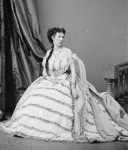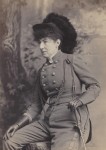 Belle Boyd was still a teenager when her career as a spy for the Confederate States of America began. Born in Martinsburg, Virginia (today West Virginia), she was 17 when war broke out in 1861. Her family, while not rich, was of old Virginia stock and she received a decent secondary education before making her debut in Washington, D.C. The whirlwind of balls and box socials was interrupted by Fort Sumter and she left D.C. to return home. Her father volunteered for the Confederate Army.
Belle Boyd was still a teenager when her career as a spy for the Confederate States of America began. Born in Martinsburg, Virginia (today West Virginia), she was 17 when war broke out in 1861. Her family, while not rich, was of old Virginia stock and she received a decent secondary education before making her debut in Washington, D.C. The whirlwind of balls and box socials was interrupted by Fort Sumter and she left D.C. to return home. Her father volunteered for the Confederate Army.
Within months Martinsburg was occupied by Federal troops. According to her autobiography, Belle Boyd saw to it that the town was occupied by one fewer Union soldier on July 4th, 1861. A group of soldiers had busted into their house, hearing that there might be Confederate flags within. When they went to raise the Union flag over the house, Belle’s mother protested and a solider retorted “in language as offensive as is possible to conceive.” Enraged, Belle whipped out the pistol she had concealed on her person and mortally wounded the Yankee soldier. The commander of the Union garrison in town investigated the shooting and declared it justified. He assigned sentries to guard the house and its residents from further interference.
And that’s how Belle Boyd got to know a passel of Union officers, charming information out of them with her wit, boldness and flirtatiousness. Mind you, there are no reports of any such shooting taking place in the official Union Army records. The account could be Belle Boyd’s fictionalized version of events invented or exaggerated for a stronger lead-up to her later spying activities which do appear on the record.
 The exploit that would make her famous took place in May, 1862, just after her 18th birthday. Either by pressing her ear to a knothole in the floor or a knothole in the wardrobe (accounts differ), she eavesdropped on Union General James Shield’s conversation with his staff at a hotel in Front Royal, Virginia. She found out that Shield’s troops were leaving, that Union numbers would be significantly reduced. Riding a horse through Union lines with fraudulent passes, Belle reached General Stonewall Jackson’s army and relayed a message to him via an officer: “The Yankee force is very small. Tell him to charge right down and he will catch them all.” On May 23rd, 1862, Jackson charged right down and defeated Colonel John R. Kenly at the Battle of Front Royal in a rout.
The exploit that would make her famous took place in May, 1862, just after her 18th birthday. Either by pressing her ear to a knothole in the floor or a knothole in the wardrobe (accounts differ), she eavesdropped on Union General James Shield’s conversation with his staff at a hotel in Front Royal, Virginia. She found out that Shield’s troops were leaving, that Union numbers would be significantly reduced. Riding a horse through Union lines with fraudulent passes, Belle reached General Stonewall Jackson’s army and relayed a message to him via an officer: “The Yankee force is very small. Tell him to charge right down and he will catch them all.” On May 23rd, 1862, Jackson charged right down and defeated Colonel John R. Kenly at the Battle of Front Royal in a rout.
News of Belle Boyd’s daring late-night run spread quickly. There were stories in southern and northern newspapers about it. She was described in the northern press as the “Siren of the Shenandoah” and “Cleopatra of the Secession.” Stonewall Jackson sent her a lovely personal thank you note and awarded her the Southern Cross of Honor. She also received an honorary commission as a Captain in Jackson’s army and an honorary appointment as his aide-de-camp.
 Belle revelled in the attention. She made no attempt to hide her actions, instead telling the story, often with embellishments including a claim that carrying a Confederate flag, she had led Jackson’s men onto the battlefield. She repeated that claim to one Frederic Sears Grand d’ Hauteville, a Union captain on the staff of General Nathaniel Banks, when she met him at Front Royal on June 10th and gave him the flag she said she had been waving when she “led the attack” on Union troops.
Belle revelled in the attention. She made no attempt to hide her actions, instead telling the story, often with embellishments including a claim that carrying a Confederate flag, she had led Jackson’s men onto the battlefield. She repeated that claim to one Frederic Sears Grand d’ Hauteville, a Union captain on the staff of General Nathaniel Banks, when she met him at Front Royal on June 10th and gave him the flag she said she had been waving when she “led the attack” on Union troops.
Another officer serving under General Nathaniel Banks wrote about Belle and the flag in a letter home on July 28th, 1862. That officer was Robert Gould Shaw, famously played by Matthew Broderick in the Oscar-winning movie Glory.
“Perhaps you have seen some accounts of a young lady at Front Royal, named Belle Boyd. There was quite a long and ridiculous letter about her copied into the ‘Evening Post’ the other day. I have seen her several times, but never had any conversation with her. Other men who have talked with her, tell me that she never asked for any information about our army, or gave them the slightest reason to suppose her a spy; and they were probably as capable of judging as the correspondent who wrote about her. She gave Fred. d’ Hauteville a very pretty Secession flag, which she said she carried when she went out to meet Jackson’s troops coming into Front Royal.”
 After seeing significant action, Frederic d’ Hauteville resigned his commission in 1863 and married socialite and scion of two great New York dynasties, Elizabeth Stuyvesant Fish. She died just 10 months later and d’ Hauteville withdrew to his family chateau on Lake Geneva. The flag traveled to Switzerland with him and remained in the house until it was sold for the first time in 2015. Yes, you read that right. A genuine historical artifact was found in a real life private Swiss collection under entirely legitimate circumstances.
After seeing significant action, Frederic d’ Hauteville resigned his commission in 1863 and married socialite and scion of two great New York dynasties, Elizabeth Stuyvesant Fish. She died just 10 months later and d’ Hauteville withdrew to his family chateau on Lake Geneva. The flag traveled to Switzerland with him and remained in the house until it was sold for the first time in 2015. Yes, you read that right. A genuine historical artifact was found in a real life private Swiss collection under entirely legitimate circumstances.
Now it is going up for auction again, for the first time in the United States.
Eleven star flags of this pattern are generally dated in the brief timespan from July 1861, when Tennessee and North Carolina joined the Confederacy, until November 28, 1861, when two additional stars were added to the flag to mark the establishment of Confederate governments in Missouri and Kentucky. Made sometime in that timespan, perhaps even by Boyd herself, this flag was packed away and preserved before it was even a year old. The flag exhibits an unusual canton configuration. While one side features the eleven stars in a circle, typical of First National flags, the other side has but a single star in the center of the canton. […]
Its condition has remained immaculate, retaining the short ribbons along its hoist and showing no tears, holes, fraying, loss, or staining. A small handwritten note has been loosely stitched to the flag, testifying to its provenance. The note reads: “Confederate flag. Taken by F.S.G d’H. and given by him to E.S.F. in 1862 (?). To be given to Freddie d’ Hauteville when he is fifteen.” The handwriting is that of Frederic d’ Hauteville, who has spelled out his name in initials. E.S.F. represents the initials of his late wife, Elizabeth Stuyvesant Fish. Freddy, his son by his second wife, was born in 1873, thus dating this note some years before his 15th birthday in 1888.
The auction will take place on September 17th, 2016, but the lot is already open for online bidding. The opening bid is $50,000. Heritage Auctions expects it to sell for much more than that, and given its impeccable provenance and exquisite condition, it may even break the record for a flag of the First National pattern. The record for Confederate flag sold at auction is the battle flag of J.E.B. Stuart which sold for $956,000 in 2006.
“Mind you, there are no reports of any such shooting taking place in the official Union Army records.”
Oh dear, reality intrudes.
Were it proven she actually punctured the hapless Federal’s body and ego, she might be in future referred to as The Belle of The Musket-Ball.
Small correction:
rout
noun
1.
a disorderly retreat of defeated troops.
“the retreat degenerated into a rout”
synonyms: retreat, flight
“the army’s ignominious rout”
Great story, as always..thank you.
:skull: Bring back the south they have rights and this isn’t about hate,it’s wrong to take the confederate flags down and away for those who were fighting for their. Rights!
The slave states had zero concern about state’s rights when it came to using federal power to uphold slavery. See the Fugitive Slave Act, for instance, or the Kansas-Nebraska act, or the Missouri Compromise. The only principle they defended was ownership of slaves, period. Read any of the seccession statements and you’ll find they’re very clear on the motivation.
The southern 99% were fighting for the southern 1%’s profit margins. No “rights” involved.
Yup. Profit margins and the human chattel that secured them.